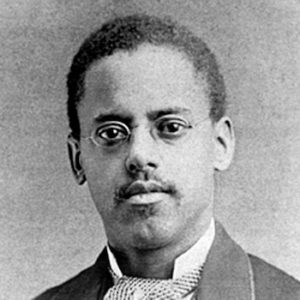
Lewis H. Latimer
*Lewis Howard Latimer was born on this date in 1848. He was a Black inventor, poet, and innovator in the electric lighting industry.
Latimer worked in his father’s barbershop in Chelsea, Massachusetts as a boy. He joined the Union Navy during the American Civil War, and after an honorable discharge in 1865, he found work with a firm of patent lawyers. Although Latimer was hired as an office boy, he cultivated drafting skills in his spare time until he was qualified for blueprint work. Latimer brainstormed his work, patenting in 1874 a "pivot bottom" for train water closets. His high-caliber draftsmanship impressed Alexander Graham Bell, whose 1876 telephone blueprints were drawn up by Latimer.
In 1880 Latimer went to work for the inventor Hiram Maxim, who ran the United States Electric Lighting Company in Bridgeport, Connecticut, and was one of Thomas Edison's prime competitors in the institutionalization of electric light. Under Maxim, Latimer supervised the installation of electric lights in New York, Philadelphia, London, and Montreal. He also developed other inventions, co-patenting an electric lamp with Joseph V. Nichols in 1881 and, most important, refining light-bulb technology in 1881. In 1884 he was invited to work for Maxim's arch-rival, Thomas Alva Edison, in New York.
An expert electrical engineer, Latimer's work for Edison was critical for the following reasons: his thorough knowledge of electric lighting and power guided Edison through the process of filing patent forms properly at the U. S. Patent Office, protecting the company from infringements of his inventions; Latimer was also in charge of the company library, collecting information from around the world, translating data in French and German to protect the company from European challenges. He patented a carbon manufacturer device in 1882; the Patent number is #252,386. Latimers. g Gobe supporter for electric lamps (co-inventor John Tregoning) was also patented #255,212. He became Edison's patent investigator and expert witness in cases against persons trying to benefit from Edison's inventions without legal permission.
Edison encouraged Latimer to write the book Incandescent Electric Lighting: A Practical Description of the Edison System. Published in 1890, it was extremely popular as it explained how an incandescent lamp produces light in an easy-to-understand manner. On February 11, 1918, Latimer became one of the 28 charter members of the Edison Pioneers, the only African American in this prestigious, highly selective group. After leaving Edison, Latimer worked for a patent consultant firm until 1922, when failing eyesight caused an end to his career. His health began to fail after his wife, Mary Wilson Latimer, died in 1924. To cheer and encourage him to carry on, his children (two daughters) had a book of his poems printed in 1925 in honor of his 77th birthday.
The beautifully sensitive poems complement Latimer's designation as a "Renaissance Man" who painted, played the flute, and wrote poetry and plays. Lewis Howard Latimer settled in Flushing, New York until he died in 1928. He was an active local community member, teaching English and drafting to immigrants at the Henry Street Settlement in 1906. In 1968, Latimer was posthumously honored by the borough of Brooklyn when a public school was named after him.
The African American Desk Reference
Schomburg Center for Research in Black Culture
Copyright 1999 The Stonesong Press Inc. and
The New York Public Library, John Wiley & Sons, Inc. Pub.
ISBN 0-471-23924-0